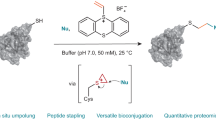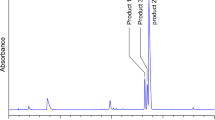Abstract
Alkylation of cysteine residues has been used extensively for characterization of proteins and their mode of action in biological systems, research endeavors that are at the core of proteomics. Treatment with a simple alkylating agent such as [2-13C] bromoethylamine would result in labeled thialysine at the ε-position. This chemical modification of proteins would allow investigations via both 13C NMR spectroscopy and mass spectrometry. However [2-13C] labeled bromoethylamine is not available commercially. We investigated its synthesis at acid pH with the goal of obtaining singly labeled bromoethylamine and understanding the mechanistic details of the reaction. Based on our experimental and theoretical results, bromination of [2-13C] labeled ethanolamine in acidic conditions takes place via exclusive attack of the nucleophile (HBr) at the hydroxyl bearing C. Moreover, hydrogen bonding guides the nucleophilic attack, resulting in no label scrambling of the bromoethylamine product. Protein alkylation at cysteine residue with the synthesized Br13CH2CH2NH2-HBr is successful. Ab initio calculations in which CH3SH serves as a model for the cysteine residue suggest that in gas phase intermolecular attack by the sulfur bearing nucleophile is favored over the intramolecular substitution by the amino group by 15.4 kJ mol−1. Solution modeling shows that the trend is preserved at basic pH, which is the experimental one, but is reversed at neutral pH.








Similar content being viewed by others
References
Vitzthum F, Behrens F, Anderson L, Shaw JH (2005) Proteomics: from basic research to diagnostic application. A review of requirements and needs. J Proteome Res 4:1086–1097
Gloerich J, Wevers RA, Smeitink JAM, van Engelen BG, van den Heuvel LP (2007) Proteomics approaches to study metabolic and genetic disorders. J Proteome Res 6:506–512
Sakal AGE, Shechter Y (1991) Biological activity of a fluorescein human growth hormone derivative prepared by specific covalent labeling of lysine-70. Biochemistry 30:8899–8904
Aison SP, Hindley D, Wang L, Shah K, Wang Y, Hu X, Shokar KM, Kolch W, Sedivy JM, Yeung KC (2004) Engineering the serine/threonine protein kinase Raf-1 to utilize an orthogonal analogue of ATP substituted at the N6 position. FEBS Lett 556:26–34
Hermanson GT (1996) Bioconjugate techniques, 1st edn. Academic, New York
Giron P, Dayon L, Sanchez JC (2011) Cysteine tagging for MS-based proteomics. Mass Spectrom Rev 30:366–395
Brotzel F, Mayr H (2007) Nucleophilicities of amino acids and peptides. Org Biomol Chem 5:3814–3820
Gregori L, Poosch MS, Cousins G, Chaw V (1990) A uniform isopeptide-linked multiubiquitin chain is sufficient to target substrate for degradation in ubiquitin-mediated proteolysis. J Biol Chem 265:8354–8357
Raftery MA, Cole D (1996) On the aminoethylation of proteins. J Biol Chem 241:3457–3459
Piotrowski J, Beal R, Hoffman L, Wilkinson KD, Cohen RE, Pickart CM (1997) Inhibition of the 26 S Proteasome by polyubiquitin chains synthesized to have defined lengths. J Biol Chem 272:23712–23721
Gorlatov SN, Stadtman TC (1998) Human thioredoxin reductase from HeLa cells: Selective alkylation of selenocysteine in the protein inhibits enzyme activity and reduction with NADPH influences affinity to heparin. Proc Natl Acad Sci USA 95:8520–8525
Hartmann S, Hofsteenge J (2000) Protein synthesis post-translation modification and degradation. J Biol Chem 275:28569–28574
Hopkins CE, O'Connor PB, Allen KN, Costello CE, Tolan DR (2002) Chemical-modification rescue assessed by mass spectrometry demonstrates that γ-thia-lysine yields the same activity as lysine in aldolase. Protein Sci 11:1591–1599
Jacobson MSG, Stark G, Vanaman T (1973) Specific chemical cleavage in high yield at the amino peptide bonds of cysteine and cysteine residues. J Biol Chem 248:6583–6591
Robert TKH, Czerwinski M, Johnson WH Jr, Legler PM, Tivers JT, Mildvan AS, Whitman CP (1999) Effects of mutations of the active site arginine residues in 4-oxalocrotonate tautomerase on the pK a values of active site residues and on the pH dependence of catalysis. Biochemistry 38:12358–12366
Garrod EHS, Connor SC, Connely JC, Spraul M, Nicholson JC, Holmes E (2001) High-resolution 1H NMR and magic angle spinning NMR spectroscopic investigation of the biochemical effects of 2-bromoethanamine in intact renal and hepatic tissue. Magn Res Med 45:781–790
Hopkins CE, Hernandez G, Lee JP, Tolan DR (2005) Aminoethylation in model peptides reveals conditions for maximizing thiol specificity. Arch Biochem Biophys 443:1–10
Thevis M, Ogorzalek Loo RR, Loo JA (2003) In-gel derivatization of proteins for cysteine-specific cleavages and their analysis by mass spectrometry. J Proteom Res 2:163–172
Řehulková H, Marchetti-Deschmann M, Pittenauer E, Allmaier G, Řehulka P (2009) Improved identification of hordeins by cysteine alkylation with 2-bromoethylamine, SDS-PAGE and subsequent in-gel tryptic digestion. J Mass Spectrom 44:1613–1621
Wystrach VP, Kaiser DW, Schaefer FC (1955) Mono-(1-aziridinyl)-s-triazines and bis-(1-aziridinyl)-s- triazines. J Am Chem Soc 77:5918–5922
Bach PL, Bridges J (1982) Synthesis of 2-bromo-1-14C]ethanamine hydrobromide. J Label Compd Radiopharm 19:425–431
Bird I, Farmer PB (1988) The synthesis of deuterium-labelled 2-bromoethanol, acrylonitrile, acrylamide, 2-aminoethanol, 2-bromethylamine hydrobromide and 1-bromo-2-chloroethane. J Label Compd Radiopharm 27:199–216
Schutte E, Weakle RJR, Tyler DR (2003) Radical cage effects in the photochemical degradation of polymers: effect of radical size and mass on the cage recombination efficiency of radical cage pairs generated photochemically from the (CpCH2CH2N(CH3)C(O)(CH2)nCH3)2Mo2(CO)6 (n = 3, 8, 18) complexes. J Am Chem Soc 125:10319–10326
Nagle AS, Salvatore RN, Byong-Don C, Jung KW (2000) Efficient synthesis of β-amino bromides. Tetrahedron Lett 41:3011–3014
Vasileiou C, Vaezeslami S, Crist RM, Rabago-Smith M, Geiger JH, Borhan B (2007) Protein design: Reengineering cellular retinoic acid binding protein II into a Rhodopsin protein mimic. J Am Chem Soc 129:6140–6148
Frisch MJ, Trucks GW, Schlegel HB, Scuseria GE, Robb MA, Cheeseman JR, Scalmani G, Barone V, Mennucci B, Petersson GA, Nakatsuji H, Caricato M, Li X, Hratchian HP, Izmaylov AF, Bloino J, Zheng G, Sonnenberg JL, Hada M, Ehara M, Toyota K, Fukuda R, Hasegawa J, Ishida M, Nakajima T, Honda Y, Kitao O, Nakai H, Vreven T, Montgomery JA Jr, Peralta JE, Ogliaro F, Bearpark M, Heyd JJ, Brothers E, Kudin KN, Staroverov VN, Kobayashi R, Normand J, Raghavachari K, Rendell A, Burant JC, Iyengar SS, Tomasi J, Cossi M, Rega N, Millam NJ, Klene M, Knox JE, Cross JB, Bakken V, Adamo C, Jaramillo J, Gomperts R, Stratmann RE, Yazyev O, Austin AJ, Cammi R, Pomelli C, Ochterski JW, Martin RL, Morokuma K, Zakrzewski VG, Voth GA, Salvador P, Dannenberg JJ, Dapprich S, Daniels AD, Farkas Ö, Foresman JB, Ortiz JV, Cioslowski J, Fox DJ (2009) Gaussian 09, Revision B.01. Gaussian, Wallingford
Head-Gordon M, Pople JA, Frisch MJ (1988) MP2 energy evaluation by direct methods. Chem Phys Lett 153:503–506
Francl MM, Pietro WJ, Hehre WJ, Binkley JS, Gordon MS, Defrees DJ, Pople JA (1982) Self-consistent molecular orbital methods. 23. A polarization-type basis set for 2nd-row elements. J Chem Phys 77:3654–3665
Lee CT, Yang WT, Parr RG (1988) Development of the Colle-Salvetti correlation-energy formula into a functional of the electron density. Phys Rev B 37:785–789
Becke ADJ (1993) Density-functional thermochemistry. III. The role of exact exchange. J Chem Phys 98:5648–5652
Hoe W-M, Cohen A, Handy NC (2001) Assessment of a new local exchange functional OPTX. Chem Phys Lett 341:319–328
Raghavachari K, Binkley JS, Seeger R, Pople JA (1980) Self-consistent molecular orbital methods. 20. Basis set for correlated wave-functions. J Chem Phys 76:650–654
McLean AD, Chandler GS (1980) Contracted Gaussian-basis sets for molecular calculations. 1. 2nd row atoms, Z=11-18. J Chem Phys 72:5639–5648
Clark T, Chandrasekhar GW, Spitznagel GW, PvR S (1983) Efficient diffuse function-augmented basis-sets for anion calculations. 3. The 3-21+G basis set for 1st-row elements, Li-F. J Comput Chem 4:294–301
Frisch MJ, Pople JA, Binkley JS (1984) Self-consistent molecular orbital methods. 25. Supplementary functions for Gaussian basis sets. J Chem Phys 80:3265–3269
Baker J, Pulay P (2002) Assessment of the Handy-Cohen optimized exchange density functional for organic reactions. J Chem Phys 117:1441–1449
Xu X, Goddart WA III (2004) Assessment of Handy−Cohen Optimized Exchange Density Functional (OPTX). J Phys Chem A 108:8495–8504
Gung VA, Khuong KS, Houk KN, Chuma A, Pulay P (2004) The Performance of the Handy/Cohen functionals, OLYP and O3LYP, for the computation of hydrocarbon pericyclic reaction activation barriers. J Phys Chem A 108:2959–2965
Gonzales JM, Allen WD, Schaeffer HF III (2005) Model identity SN2 reactions CH3X + X- (X = F, Cl, CN, OH, SH, NH2, PH2): Marcus theory analyzed. J Phys Chem A 109:10613–10628
Bento AP, Sola M, Bickelhaupt FM (2005) Ab initio and DFT benchmark study for nucleophilic substitution at carbon (S(N)2@C) and Silicon (S(N)2@Si). J Comput Chem 26:1497–1504
Swart M, Sola M, Bickelhaupt FM (2007) Energy landscapes of nucleophilic substitution reactions: a comparison of density functional theory and coupled cluster methods. J Comput Chem 28:1551–1560
Zhao Y, Truhlar DG (2008) Density functionals with broad applicability in chemistry. Acc Chem Res 41:157–167
Bento AP, Sola M, Bickelhaupt FM (2008) E2 and S(N)2 reactions of X- + CH3CH2X (X = F, Cl); an ab initio and DFT benchmark study. J Chem Theor Comput Chem 4:929–940
Baker J, Muir M, Anzelm J (1995) A study of some organic reactions using density functional theory. J Chem Phys 102:2063–2080
Barone V, Adamo C (1996) Proton transfer in the ground and lowest excited states of malonaldehyde: a comparative density functional and post–Hartree–Fock study. J Chem Phys 105:11007–11020
Bach RD, Glukhotsev MN, Gonzales C (1998) High-level computational study of the stereoelectronic effects of substituents on alkene epoxidations with peroxyformic acid. J Am Chem Soc 120:9902–9910
Gritsenko OV, Ensing B, Schippers PRT, Baerends EJ (2000) Comparison of the accurate Kohn−Sham solution with the generalized gradient approximations (GGAs) for the SN2 Reaction F- + CH3F → FCH3 + F-: a qualitative rule to predict success or failure of GGAs. J Phys Chem A 104:8558–8565
Krenske EH, Peter RC, Zhu Z, Houk KN (2011) Transition States and Energetics of nucleophilic additions of thiols to substituted α, β-unsaturated ketones: substituent effects involve enone stabilization, product branching, and solvation. J Org Chem 76:5074–5081
Barone V, Cossi M (1998) Quantum calculation of molecular energies and energy gradients in solution by a conductor solvent model. J Phys Chem A 102:1995–2001
Cossi M, Rega N, Scalmani G, Barone V (2003) Energies, structures, and electronic properties of molecules in solution with the C-PCM solvation model. J Comput Chem 24:669–681
Legault CY (2009) CYLview, 1.0b, Université de Sherbrooke. (http://www.cylview.org)
Laerdahl JK, Uggerud E (2003) Part I. Nucleophilic identity substitution reactions. The reaction between water and protonated alcohols. Org Biomol Chem 1:2935–2942
Jaramillo P, Domingo LR, Perez P (2006) Towards an intrinsic nucleofugality scale: the leaving group (LG) ability in CH(3)LG model system. Chem Phys Lett 420:95–99
Author information
Authors and Affiliations
Corresponding author
Electronic supplementary material
Below is the link to the electronic supplementary material.
ESM 1
(DOC 1060 kb)
Rights and permissions
About this article
Cite this article
Marincean, S., Rabago Smith, M., Beltz, L. et al. Selectivity of labeled bromoethylamine for protein alkylation. J Mol Model 18, 4547–4556 (2012). https://doi.org/10.1007/s00894-012-1461-9
Received:
Accepted:
Published:
Issue Date:
DOI: https://doi.org/10.1007/s00894-012-1461-9




